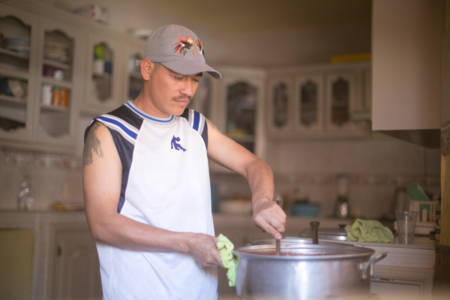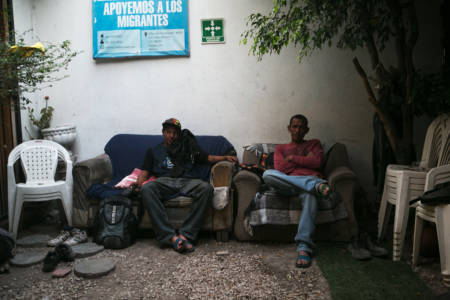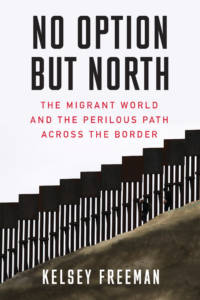Written by Kelsey Freeman
The world of migration is plagued with impossible choices, choices that aren’t really choices at all.
This was certainly the case for Jacqui, a Salvadorian woman headed north with her husband, Ernesto, and their three and six-year-old daughters. When I spoke with Jacqui at a migrant shelter where I was living in Celaya, Mexico, she was eight months pregnant with her third daughter. Shadows unrolled across her face as the trauma of what she had already endured creased her forehead. She was months into a perilous journey through Guatemala, Mexico, and across the U.S. southern border, navigating a web of violent forces targeting migrants. As her daughters doodled in the corner of the migrant shelter where we met, she did her best to mitigate her family’s vulnerability. But so much of her story was already out of her hands.
Jacqui and Ernesto had worked on coffee plantations all their lives, yet when the price of coffee plummeted, they soon found themselves without jobs and without options. El Salvador’s coffee industry—the economic lifeline for so many rural farmers—has long been in decline, due to falling global prices and lack of investment. But experts understand that in El Salvador (and across the globe), climate change is already compounding these challenges. Shorter and erratic rainy seasons have decimated coffee farms, and warmer temperatures have made plants more susceptible to coffee leaf rust and other diseases. As a result, El Salvador’s coffee industry has lost over 80,000 jobs in the past ten years, and 20 percent of Salvadorians now live in the U.S.

Ernesto cooks dinner at the migrant shelter in Celaya. Ernesto did constant volunteer work around the shelter so that his family could stay for multiple months. (Photo by Tess Freeman)
For Jacqui and Ernesto, gang violence further limited their choices. There were no other jobs in their rural village, and because of arbitrary gang territories across the country, they couldn’t move to another city to find work. “At least in the old days,” Ernesto described, “we could go and work in another town, but not anymore because the town where I live is one gang’s (territory) and the town that I go to is another gang’s. Just because I live in one territory, I can’t go into another gang’s territory anymore.”
In 2016 and 2017, I spent a year on a Fulbright Fellowship interviewing Central American migrants on their journey north for my nonfiction book No Option but North: The Migrant World and the Perilous Path Across the Border (IG Publishing, 2020). After speaking with hundreds of migrants and several experts and government officials, the intersections between gang violence, economics, and climate change became clear. They form a triangle of overlapping and mutually reinforcing powers that cause people to abandon their homes altogether. Rarely do we recognize individuals like Jacqui and Ernesto as climate migrants.
Rarely do we see the ways in which climate change works to exacerbate the forces that already compel migrants to flee. We think that when sea levels rise enough to cover landmasses, we will see our climate migrants. However, if we look at the whole picture of elements driving people north, we find that our climate refugees are already here.
Unfortunately as climate change continues to stress resources, exacerbate drought, spur extreme weather events, and cause sea levels to rise, migration caused by climate change will be one of the most pressing issues of our time, testing the limits of our international cooperation. In 2018, the World Bank estimated that three regions most impacted by climate change (Latin America, Southeast Asia and sub-Saharan Africa) will produce an additional 143 million climate migrants by 2050. Already, we have witnessed the sheer magnitude of climate migration, with an estimated 22.6 million displaced by extreme weather events in 2017 alone, which scientists unequivocally link to climate change.
If the U.S. is going to step up and be a leader on climate change, it also has to address the needs of those dislodged by the damage industrialized nations like us have already done to the planet. Climate change disproportionately displaces our world’s most vulnerable populations—like Mayan farmers in Oaxaca, Mexico driven north by drought or the Alaska Native village of Kivalina, whose island nation could be underwater as soon as 2025. While some affected communities may be able to migrate within their country, when climate change compounds other factors (such as economics or gang violence), international migration may be the only option.
If the U.S. wants to be a leader in human rights, we have to drastically expand our legal immigration system, allowing climate migrants a clear path to seek refuge. Even though we have already witnessed climate-caused migration, there are no binding agreements that protect climate migrants in international law. To date, the United Nations High Commissioner for Refugees (UNHCR) has refused to designate climate migrants as refugees, since refugee status is a very strict legal definition used to protect those persecuted in their home countries because of their race, nationality, religion, political opinion or membership in a particular social group. Even Central American victims of gang violence lose their pleas for asylum in the U.S. over 80 percent of the time. In 2015, a family applied for refugee status in New Zealand after fleeing the soon-to-be underwater nation of Kiribati—as clear of an example of climate-caused migration as you can get—yet the case was ultimately dismissed. If we care about human life and the right to seek refuge, the U.S. needs to lead the charge to either broaden the definition of refugee or create a new legal category altogether.

Photo by Tess Freeman
As I routinely saw in the cases of migrants I interviewed in No Option but North, when individuals flee by necessity but lack viable options to come to the U.S. legally, they are forced to take on the violent journey through Mexico and across the southern border. It’s hard to overstate the violence and trauma these migrants knowingly endure.
“Nothing bad has happened to us so far,” Ernesto told me. Tellingly, he did not consider sleeping in the streets, walking hundreds of miles with toddlers, being robbed and threatened by random criminals, and taking a freight train that was never meant for passengers, as “bad” (all of which had occurred). He knew how bad the journey could be. He had heard about the hundred of migrants kidnapped by cartels, tortured and held hostage for a meager ransom. He knew about what happens to an estimated 80 percent of women who attempt the journey north. He had heard about the women that take birth control while heading for the U.S., literally preparing for the likelihood of rape. I had too. I had spoken to such women. When someone is taking birth control—accepting the probability that they will experience life-altering trauma—their capacity for suffering is so far beyond what is just or decent. It speaks to a stark truth: that there’s greater suffering at home.
How many more will we force into this harrowing journey north? The need to flee will not go away; rather it will be magnified to unimaginable levels with climate change. We can continue to try to deter migrants—build a wall, separate families, create more bureaucratic hurdles—or we can accept the reality that those who leave already have “no option but north.” Mitigating the worst effects of climate change (with a comprehensive shift to renewable energy) and institutionalizing legal avenues for migration will both be crucial in this fight. Both are about protecting the dignity of human lives.
About the Author:
Kelsey Freeman is the author of No Option but North: The Migrant World and the Perilous Path Across the Border. She writes on immigration, social justice and climate and runs a college-prep program for Native American high school students in Bend, Oregon.

